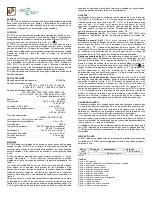
2/14/2007
Page - 16
Making Contacts with a Fixed-Frequency — Direct-Conversion Rig
Making contacts with this type of rig can be a challenge, but its not impossible. In fact, it can be a lot of fun and
satisfying. Just remember, it’s easier to have stations come to you. The reason for this is because the receiver will
hear stations on both sidebands, you don't know which side band your hearing them on. They could be on your
transmit frequency of 7.040 or down at 7.039. Also, although the audio band pass filter adds some selectivity, it’s
hard to tell how close to your operating frequency they really are; especially if the station is pretty strong. You
could be hearing them well, but your transmitting too far from their operating frequency for them to hear you. That
being said, it can pay to try and answer a CQ you hear anyway, especially if they are signing QRP or QRPp. Then
you pretty much know they are on 7.040 and some operators actually use RIT to tune around a little for answering
stations. Or they could be using one of these rigs or a Rock-Mite.
It also helps to carefully pick the time of day and day of the week to operate this rig. You want to pick a time of day
and day of the week when the band isn't overly active. Contest weekends and early evening prime time are out.
Good times are Sunday afternoon or evening, mornings, afternoons and late evenings during the week.
Keyer Operation
The momentary switch is used to access three keyer functions, speed, tune mode and iambic A/B selection.
Clicking and holding closed the switch for various lengths of time access these functions.
Changing Code Speed
Keying speed can be selected from about 7 to 30 wpm, in 1 wpm steps. Momentarily click the switch closed until
the letter “S” is heard. Tapping the dash paddle increases the speed and tapping the dot paddle decreases speed.
A dot will sound at each code step. The letter “I” will sound when the upper or lower speed limit is reached. Code
speed mode will automatically exit if neither paddle is closed for about 1 second.
Tune Mode
This mode allows you to toggle the transmitter on and off, using the paddles. This frees up both hands to fiddle
with an antenna tuner. To access tune mode, click and hold closed the switch until the letter “T” sounds. Tapping
the dash paddle will toggle the transmitter on and tapping the dot paddle will toggle it off. To exit tune mode, click
the switch again.
Iambic A/B Mode
The keyer uses iambic B mode as the default. This can be changed to A mode by clicking and holding closed the
switch until the letter “A” sounds (about 2 seconds). This change isn't remembered by the keyer chip, so it has to
be changed each time power is cycled. In either A or B mode, holding closed both paddle will produce alternating
dots and dashes. In B mode, provided the paddles are not released before the end of the inter-element space, an
extra dot or dash is added to the end of the string.
Straight Key Mode
If a mono plug is in the paddle jack at power up, the keyer will go into straight key mode. In this mode, there is no
need for the function switch, so it is disabled.
Содержание DC40A
Страница 18: ...2 14 2007 Page 18...



































